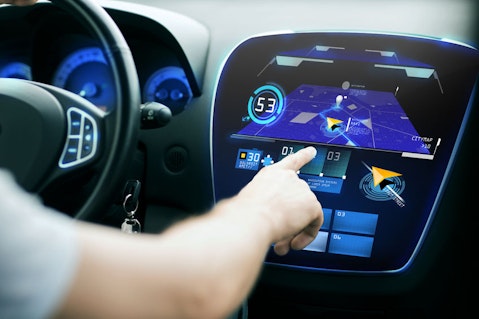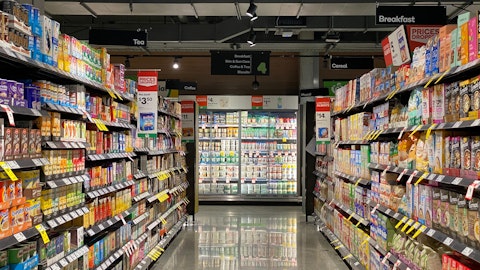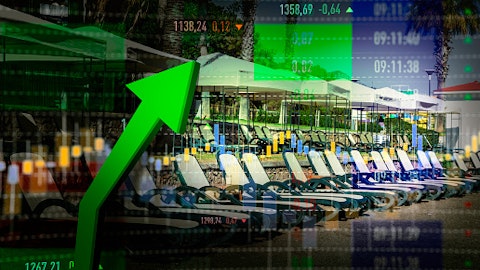Asbury Automotive Group, Inc. (NYSE:ABG) Q1 2023 Earnings Call Transcript April 25, 2023
Asbury Automotive Group, Inc. beats earnings expectations. Reported EPS is $8.37, expectations were $8.
Operator: Greetings, and welcome to Asbury Automotive Group’s First Quarter 2023 Earnings Conference Call. At this time, all participants are in a listen-only mode. A question-and-answer session will follow the formal presentation. . As a reminder, this conference is being recorded. I would now like to turn the conference over to your host, Karen Reid, Vice President and Corporate Treasurer. Thank you. You may begin.
Karen Reid: Thanks, Rob, and good morning, all. As noted, today’s call is being recorded and will be available for replay later this afternoon. Welcome to Asbury Automotive Group’s first quarter 2023 earnings call. The press release detailing Asbury’s first quarter results was issued earlier this morning and is posted on our website at investors.asburyauto.com. Participating with me today are David Hult, our President and Chief Executive Officer; Dan Clara, our Senior Vice President of Operations; and Michael Welch, our Senior Vice President and Chief Financial Officer. At the conclusion of our remarks, we will open the call up for questions and will be available later for any follow-up questions. Before we begin, we must remind you that the discussion during the call today is likely to contain forward-looking statements.
Forward-looking statements are statements other than those which are historical in nature, which may include financial projections, forecasts and current expectations, each of which are certain to subject — subject to certain uncertainties. For information regarding certain of the risks that may cause actual results to differ materially from these statements, please see our filings with the SEC from time to time, including our Form 10-K for the year ended December 2022, and subsequently filed quarterly reports on Form 10-Q and our earnings release issued earlier today. We expressly disclaim any responsibility to update forward-looking statements. In addition, certain non-GAAP financial measures, as defined under SEC rules may be discussed on this call.
As required by applicable SEC rules, we provide reconciliations of any such non-GAAP financial measures to the most directly comparable GAAP measures on our website. We’ve also posted an updated Investor Presentation on our website investors.asburyauto.com highlighting our first quarter results. It’s my pleasure to now hand the call over to our CEO, David Hult. David?
David Hult: Thank you, Karen, and good morning, everyone. Welcome to our first quarter earnings call. I am proud of the team’s performance in Q1 and the execution of our business model across its diverse revenue and profit streams. As expected, we are starting to see trends as the industry begins to normalize. We are strategically operating within a changing environment, and we continue to prioritize profitability. Over the last couple of years, pre-owned has been depleted due to fleet levels and lack of leasing. Overall, with this limited availability of pre-owned inventory in an unbalanced new inventory by brand, we are focused on maximizing our gross profit streams. Now, to our consolidated results. As a reminder, during 2022, we divested of 16 stores, four occurring in the first quarter, three in the second quarter, and nine in the fourth quarter.
These stores contributed $683 million in revenue last year. Now, for the first quarter of 2023, we generated $3.6 billion in revenue, had a gross profit margin of 19.4%. Our SG&A as a percentage of gross profit was 57.9%, had an operating margin of 7.7%, and our EBITDA was $294 million. We delivered an EPS of $8.37, and we repurchased 110,000 shares for $21 million. In addition, from the start of the second quarter through yesterday, we purchased 32,000 shares for $6 million. We continue to monitor the marketplace for acquisitions that meet our stringent thresholds for returns and that are a fit for the company from a cultural and operational view. Our mindset continues to be that we are opportunistic, strategic, and thoughtful in maximizing our returns for our shareholders.
Now, expanding to all stakeholders, I would like to highlight that we published our second Corporate Responsibility Report at the end of March. We invite you to read it if you haven’t already. Finally, I would like to thank my fellow team members for a strong start to 2023. The guest centric experience begins with you and we are looking forward to what is in store. Thank you. I will now hand the call over to Dan to discuss our operating performance. Dan?
Dan Clara: Thank you, David, and good morning, everyone. I would also like to extend my thanks to all of our hardworking team members for consistently delivering an exceptional guest experience. Now, moving to the same-store performance, which includes dealerships in TCA unless stated otherwise. As a reminder, we acquired many stores as well as TCA in late 2021, which have now entered our same-store results for the quarter. Also, the 16 stores that were divested during 2022 are excluded from same-store. Starting with new vehicles. Our new vehicle inventory ended the quarter at $643 million, which represents a 30-day supply. Our day supply fluctuated by segment with domestic being at 63 days, import at 18 days, and luxury at 28 days, and varying greatly among brands and models within those segments.
Our new vehicle volume was down 4% year-over-year, while we grew new vehicle revenue by 3%. New average gross profit per vehicle was $5,184, a decrease of $616 from the prior year quarter. Turning to used vehicles. Used retail revenue was down 9% through prior year quarter, mainly due to the dropping cost of sales. Used retail gross profit per vehicle was $2,146 for the quarter, a decrease of $385 from the per year quarter. Our used vehicle inventory ended the quarter at $309 million, which represents a 27-day supply. Shifting to F&I. We delivered an F&I PVR of $2,352, a decrease of $192 compared to the prior year quarter. Regarding consumer financing in general, we did not see a miserable impact of credit timing in the quarter. In the first quarter, our total front end yield per vehicle was $6,053, a decrease of $675.
Moving to parts and service. Our parts and service business was a source of strength in the quarter. Revenue increased 12% in the quarter, customer pay revenue continued its upward momentum with 14% growth, and we expanded its gross profit by 13%. Now, turning to Clicklane. Please note that for Clicklane, we are reporting on an all store basis. We set an all-time record of over 10,800 vehicles through Clicklane in the first quarter, a 93% increase year-over-year and a 28% increase over the previous best, which was last quarter. Approximately, 16% of our first quarter of 2023 total retail sales were powered by Clicklane and we achieved 39% of 2022 annual Clicklane sales in just the first quarter. We generated approximately $450 million in Clicklane revenue for the quarter, and we are on track for our $2.5 billion revenue estimate for Clicklane, our tool that offers a full omni-channel experience and guest centric features.
Moving on to some KPIs from the first quarter. Average transaction time remained in line with prior quarters, eight minutes for cash deals and 14 minutes for finance deals. Total front end PVR of $3,601 and an F&I PVR of $2,275, which equates to $5,876 of total front end yield. The average Clicklane customer credit score was 7.21, which is higher than the average credit score at our stores. 89% of those that applied were approved for financing, of which 90% of those customers received the instant approval while the remaining customers required some offline assistance. 72% were lender finance sales and 28% were cash sales. The average distance of a Clicklane delivery from our dealerships was 18.1 miles, which allows us to retain customers in our high-margin parts and service departments.
In our journey to become the most guest centric automotive retailer, we recognize that the most important differentiator that we have is the level of service we provide. Then, trust, loyalty, and retention naturally follow. I will now hand the call over to Michael to discuss our financial performance. Michael?

Copyright: dolgachov / 123RF Stock Photo
Michael Welch: Thank you, Dan. To our investors, analysts, team members, and other participants on our call, good morning. I would like to provide some financial highlights for our company. For additional details on our financial performance for the quarter, please see our financial supplement in our press release today and our Investor Presentation on our website. Overall, net income was $181 million and EPS was $8.37 for the quarter. There were no non-GAAP adjustments to net income in the first quarter of 2023. Adjusted net income for the first quarter of 2022 excludes gains net of tax of $25.5 million related to $33.1 million gain on the sale of four dealerships and a $900,000 gain on a sale leaseback. This adjusted 2022 first quarter EPS by $1.11 to $9.27.
Our effective tax rate for the first quarter of 2023 was 23.9% compared to 24.2% for the first quarter of 2022. We estimate our tax rate for the remainder of 2023 to be approximately 24.5%. Excluding real estate purchases, we spend approximately $15 million on capital expenditures in the first quarter. We expect full-year 2023 CapEx to be $200 million as we continue to rollout our planned CapEx related to our 2021 acquisitions. Of this $200 million, about $20 million is expected to be related to the replacement of lease property. For the quarter, TCA made $17 million of pre-tax income, which excludes $3 million of net unrealized gains. We have rolled out TCA to all of our stores in Colorado, Texas, and St. Louis, and we expect to deploy TCA into the rest of our stores by the end of 2023.
Due to the deferral of the income associated with the store rollouts, we expect TCA to generate $25 million of pre-tax income for 2023, a decrease from the $80 million in 2022. Our balance sheet remains strong as we ended quarter with approximately $1.7 billion of liquidity comprised of cash, excluding cash to total care auto, floor plan offset accounts and availability on both our used line and revolving credit facility. Even with our sizeable acquisitions in recent years, we have managed our debt levels strategically to support our long-term growth. Our pro forma adjusted net leverage was 1.6x at the end of March. For the first quarter of 2023, we generated $244 million of adjusted operating cash flow driven by our strong business model. With our robust cash flow generation, we have the flexibility to achieve our strategic goals and be able to seize opportunities.
We constantly gauge the market for potential acquisitions that would further enhance our strong portfolio versus repurchasing shares to return capital to shareholders. Finally, I would also like to thank our Asbury team members. Our result is driven by your dedication to the guest centric model. I will now hand the call back over to David to provide some closing remarks. David?
David Hult: Thank you, Michael. I’m encouraged by our results, especially from a same-store performance. In an age car park, we still historically depress our levels and the complexity of newer cars, such as EVs bodes well for our strong parts and service business. We have been and continue to be strategic in our philosophy and in our actions. With our strong cash flow and balance sheet, which has grown more robust over time, we are opportunistic for potential acquisitions and buybacks. This concludes our prepared remarks. We’ll now turn the call over to the operator and take your questions. Operator?
See also 16 Best Utility Stocks to Buy Now and 15 Biggest SaaS Companies in the World.
Q&A Session
Follow Asbury Automotive Group Inc (NYSE:ABG)
Follow Asbury Automotive Group Inc (NYSE:ABG)
Operator: Thank you. At this time, we’ll be conducting a question-and-answer session. . Our first question comes from Daniel Imbro with Stephens, Inc. Please proceed with your question.
Daniel Imbro: David, you guys have done a great job. I feel like on the new vehicle side, especially with some of the elevated production at some of the domestic OEMs. I guess one, other than Clicklane, are there things you guys are doing operationally to protect that GPU margin or improve the vehicle sales trends? And then second, as a related one, what percent of new units are sold on pre-order today and maybe how has that trended as we try to assess the demand backdrop here in terms of what’s getting pre-sold?
David Hult: Daniel, this is David, I’ll take it and Dan can jump in. Last quarter, about 38% of our cars were pre-sold on incoming. For Q1, it dropped to 33%. So we still think a pretty healthy number, but there certainly was a drop there as well. On the pre-owned side, sequentially, we actually went up in PVR. We just determined that it didn’t make sense to chase volume. Our gross profits are not so much about the sale price, but the acquisition price because the market dictates what the selling price is going to be. So we weren’t aggressive at buying cars from auctions or anything like that. We focused on trade-ins, off lease vehicles and purchasing cars direct from consumer. We felt it was a better trade-off to have lower volume and higher gross profits, which really generated a better EPS for us overall.
Dan Clara: David, I have nothing to add. I think you covered it well.
Daniel Imbro: And then on that used side – thank you for that. Maybe to follow-up, it’s still obviously a point of weakness out there in the market. Are you seeing any discernible change in that pre-owned buyer or consumer? Are you seeing it trade down? Are you seeing lower product attachment on F&I? And anything that would tell you that consumer is materially changing from how they’ve been lost couple of quarters.
David Hult: You can see on our cost of sale, it dropped a little bit for the first time in a couple of years. So we see that as a good sign. Certainly, with all the interest rate increases over time, that’s put more pressure on the payment. So I think people are not reacting as quickly and being more thoughtful about taking time. The biggest challenge right now, as you can imagine, is finding the right fit. Really trying to find those cars that people are looking for so you can turn them in a quick manner, if you will. So again, we believe the focus almost 70% of the cars that we’re selling right now are trade-ins and off-lease vehicles. And we feel if we can maintain that we can hold onto margin as best we can, which is what our focus is going to be.
Daniel Imbro: Great. And then last one for me, Michael, as a follow-up on the financials, I guess $1.1 billion in cash on the balance sheet, you just did the divestitures in 4Q. What is the appetite for M&A? And are there any certain markets or brands you would like to fill in or are trying to fill in specifically with that cash?
Michael Welch: Yes, I mean, we’re still out there looking strategically for acquisitions. We like the markets we’re in. We’re trying to find those strategic acquisitions that make sense for us and then comparing that to the share buyback opportunities that are out there in the market as well. So trying to balance those two items with the cash, with the environment what it is and the uncertainties just in the economy, I think being a little bit just strategic with our cash and waiting for the right opportunities is the best approach right now just with that uncertainty in the markets.
David Hult: And this is David, I’ll just say we’re seeing a good amount of M&A activity and seeing opportunities come our way, just haven’t been able to land something that we feel really strongly about.
Daniel Imbro: Great. Well, best of luck going forward and thanks for all the detail.
David Hult: Thank you.
Operator: Our next question is from Adam Jonas with Morgan Stanley. Please proceed with your question.
Adam Jonas: Hey, everybody, good morning. So my first question is, I think, in your prepared remarks, you said that there was no measurable sign of financial tightening during the quarter. How about after the quarter? My first question.
David Hult: Yes, Adam, this is David. Not yet. I would tell you as a reminder, we normally state that our subprime as a percentage of our business is about 10%. Last month in the quarter is just over 7% of our business. So our core customers over a 700 credit score. We have over 250 lenders that we’re signed up with. So we have a lot of options and we’re not seeing any tightening as we sit here today.
Adam Jonas: Okay. So just to interpret that, going from 10 to 7, maybe there is tightening, but you don’t see it because it’s happening on the lender side, right? Is that a fair interpretation, yes —
David Hult: Well, so I would tell you, our store locations, our go-to-market in how we go after our business, we’re just not aggressive looking for subprime. So I wouldn’t say there’s — I wouldn’t look at it that way as much. And as you can imagine with those number of lenders that we have, certainly some have tightened up their practices compared to others. But again, because of the majority of the polarity of the banks that we have available to us, we just don’t have an issue seeking lending.
Adam Jonas: I got it. Thanks, David. Just to follow-up, can you update us on your current percentage of your new sales that are ordered to delivery or pre-ordered, let’s say maybe how that’s trended, where that was kind of exiting last year or a year ago. And then any comment on ATP versus MSRP, that gap there would also be helpful given the environment? Thanks.
David Hult: Sure. I hope I get all of it. Last quarter, fourth quarter of 2022, 38% of our vehicles were pre-sold that were incoming. In Q1, it was 33%, so a little bit of a drop off there.
Karen Reid: ATP versus MSRP.





